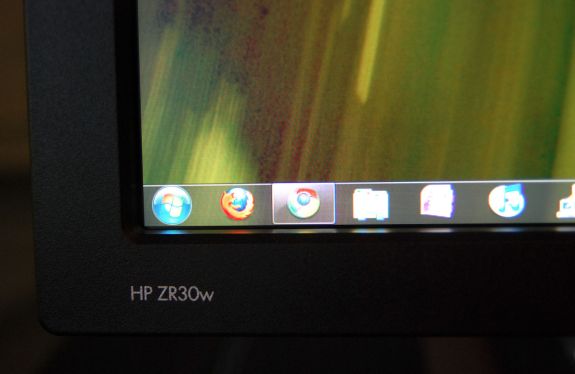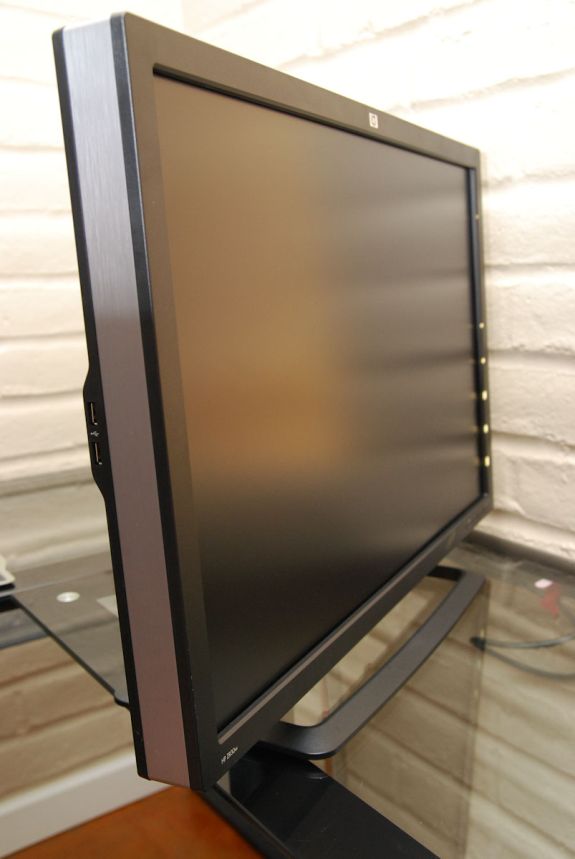A New 30" Contender: HP ZR30w Review
by Brian Klug on June 1, 2010 6:30 PM EST
Opining for an OSD
As I mentioned before, there’s no OSD to speak of. The only options exposed to users are input selection, brightness, and dynamic contrast. A blue LED at right flashes three times when you’ve reached the upper or lower brightness limits, and flashes four times when dynamic contrast is turned on, once when turned off. The LED is off when the display is in operation, and amber when in standby. The rest is up to you.
Spartan Scaling Selections
I also already touched on scaling which appears to be pretty barebones for reasons discussed earlier. You can pixel double by going with 1280x800, or go for native, or choose another resolution and everything upscaled with some smudging. There's no 1:1 option, or any options whatsoever. Honestly, I can’t think of any reasons why you wouldn’t drive an LCD at anything other than native resolution. The dot pitch of the ZR30w is fabulous at 0.250 mm, if you’re paying for those pixels, use them, then use DPI controls in the operating system if text and UI is too small. The ZR30w does scale other aspect ratios that I tested properly, but don't expect too much. Honestly it still makes no sense to drive a display this high resolution at anything but native.
Final Thoughts
The 30” segment of the LCD market demands the best of the best. It’s indisputably the ring in which every manufacturer wages battle with its flagship monitor. Solid execution here usually translates to solid performance for smaller size panels in the same lineup. Suffice it to say that HP’s 30 inch ZR series successor to the LP3065 doesn’t disappoint.
Spartan Scaling Selections
I also already touched on scaling which appears to be pretty barebones for reasons discussed earlier. You can pixel double by going with 1280x800, or go for native, or choose another resolution and everything upscaled with some smudging. There's no 1:1 option, or any options whatsoever. Honestly, I can’t think of any reasons why you wouldn’t drive an LCD at anything other than native resolution. The dot pitch of the ZR30w is fabulous at 0.250 mm, if you’re paying for those pixels, use them, then use DPI controls in the operating system if text and UI is too small. The ZR30w does scale other aspect ratios that I tested properly, but don't expect too much. Honestly it still makes no sense to drive a display this high resolution at anything but native.
Final Thoughts
The 30” segment of the LCD market demands the best of the best. It’s indisputably the ring in which every manufacturer wages battle with its flagship monitor. Solid execution here usually translates to solid performance for smaller size panels in the same lineup. Suffice it to say that HP’s 30 inch ZR series successor to the LP3065 doesn’t disappoint.
We would’ve liked to see just a bit more color accuracy, but the tradeoff for a dramatically bigger gamut is a good one to make. The ZR30w blew past the advertised 99% of AdobeRGB, coming in at just over 111% of the volume. It’s important to note that HP likely means coverage overlap of 99%, which the ZR30w does meet. But heck, having a volume bigger than the AdobeRGB volume is more notable. In person, the ZR30w is impressive all around. It’s bright, contrasty, and has colors that put my daily use monitors and others I’ve got laying around to shame; not an easy thing to do.
At an MSRP of $1,299, the ZR30w is priced aggressively and below its predecessor and competition. If you don’t mind lacking an extra DVI port, the increase in gamut volume is a notable difference. It’s likely that both lack of an OSD as well as accessory VGA, HDMI, component or composite inputs is related to the lack of a compatible control IC. Instead, there’s likely a simple scaler so we see minimal processing lag for an IPS panel, and unfortunately minimal user control. This is a bold move on HP’s part to continue for a second generation, but likely keeps cost and input processing lag low.
At an MSRP of $1,299, the ZR30w is priced aggressively and below its predecessor and competition. If you don’t mind lacking an extra DVI port, the increase in gamut volume is a notable difference. It’s likely that both lack of an OSD as well as accessory VGA, HDMI, component or composite inputs is related to the lack of a compatible control IC. Instead, there’s likely a simple scaler so we see minimal processing lag for an IPS panel, and unfortunately minimal user control. This is a bold move on HP’s part to continue for a second generation, but likely keeps cost and input processing lag low.
Interestingly enough, this is definitely the way that things are going for display controls, with a growing number offering DDC control as the exclusive option for tweaking settings. In practice, what HP offers with the front controls is almost all you need, so long as you can calibrate to your liking in software. Perhaps we might have gotten under a Delta E of 1.0 with some RGB sliders, but who’s to say?
The ZR30w is definitely a serious contender among 30” displays. It’s an attractive package that wows with above average color tracking, an impressive gamut, and a competitive price, but lacks some of the extra “accessory” inputs that consumers are starting to demand. That said, it looks like the ZR30w is a solid option if you’re looking for a 30” display with an unbeatable color gamut.












95 Comments
View All Comments
Taft12 - Wednesday, June 2, 2010 - link
http://accessories.dell.com/sna/products/Docking_S...$150 CAD - if that's a tough sell, how did you convince them to buy you a monitor that costs over $1000?!
theangryintern - Thursday, June 3, 2010 - link
that's weird. We order docking stations with every single laptop we order. When people are in their office, they all want dual 22" displays.DigitalFreak - Tuesday, June 1, 2010 - link
I'm happy with my Dell U2410 and its HDMI, DVI x 2, Display Port, etc. inputs. :-)ghitz - Wednesday, June 2, 2010 - link
We're talking about 30" here!thorr2 - Tuesday, June 1, 2010 - link
I have the LG W3000H-Bn that I got from newegg. I am very happy with it although it is on the green side before calibration. It would be interesting to see a professional review of it to see how it compares to the others. It is definitely cheaper than a lot of the competition.zsero - Tuesday, June 1, 2010 - link
Sorry, but there is a big misunderstanding in this article:> I have no trouble believing that HP's claims about 1+ billion colors are totally accurate - you have to
> see it in person to believe it. There are just some colors I'm used to not seeing represented very
> well; reds and blues especially, and the photos that I have looked at are spectacular.
Color gamut and the number of colors are totally different things!
But what is _missing_ from the article is that:
1. Using 24 bit color (8-bit per color) with a calibrated display profile you get visible banding.
2. Using 30 bit color (10-bit per color) you can calibrate a monitor without visible banding.
3. For 30 bit color you need DisplayPort and a professional graphics card + driver + OS + software support. For example newest professional Nvidia Quadro or Matrox cards, with a good combination of software and OS!
4. What you have seen was less than 16 million colors, as you have used DVI and a calibrated output from a consumer graphics card.
5. The billion color thing is nothing but the good sounding fact that 2^30 > billion (actually it's 1 billion, 73 million, 741 thousand and 824)
Brian Klug - Tuesday, June 1, 2010 - link
I totally agree and I'm glad someone caught me ;) To be honest, I'm still a bit confused about the 32-bit color setting in windows in the display driver window and how that relates to the 30-bit claim. It would seem to me that 32-bit true color is indeed being driven, no? There's definitely no banding visible, at least from what I've scrutinized.I did space on trying DisplayPort though, I'm going to give that a shot in a second here and will probably update if I find something interesting! ;)
Cheers,
Brian
Brian Klug - Tuesday, June 1, 2010 - link
I now follow completely what you mean. I tried using DisplayPort and DVI both to pass 10-bit Deep Color to the ZR30w, but apparently that feature isn't implemented on the ATI HD5870. I'm hoping to try it on a 2010 MBP, but it'll be some time before my miniDP to DP adapter arrives so I can test.Until then, I'm not entirely sure what the status is, but realize this is an important concern and chief feature of the ZR30w. I'm going to continue to investigate. Honestly, I don't expect the gamut to change that much, but it would indeed be interesting to see if 10-bit deep color does work as advertised. I might need a better workstation card. I'll update when I find out.
Cheers and thanks!
Brian
prof.yustas - Tuesday, June 1, 2010 - link
Excellent. Thank you. In addition, it would be very useful to hear your take on the best 24-inch 16:10 (not 16:9) display out there, which is another way of asking for the DELL U2410 vs. HP ZR24w comparison.Mr Perfect - Wednesday, June 2, 2010 - link
http://www.tftcentral.co.uk/ has reviewed both, if you're interested.